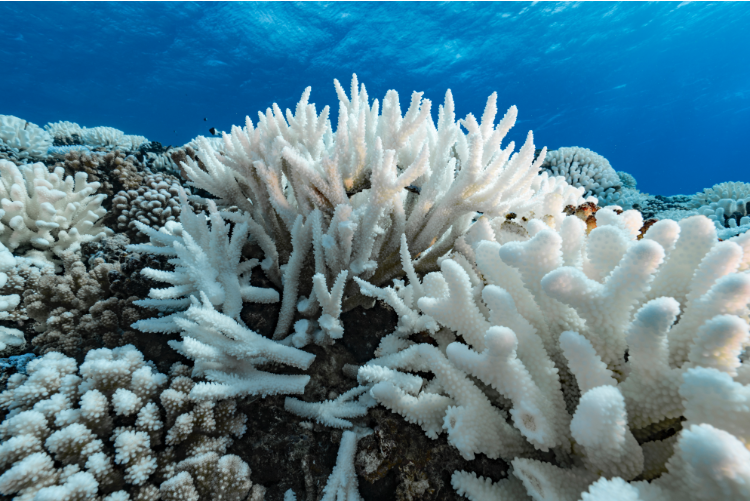Our planet is currently in the midst of another mass global coral bleaching event, the fourth in three decades, as soaring ocean temperatures cause corals in the three major ocean basins to bleach, according to NOAA’s Coral Reef Watch. This event is expected to exceed the scale and severity of the previous event of 2014-2017, which was the worst on record. The accelerating loss of the world’s coral reefs casts an ominous shadow over the future of our planet. Corals have inhabited our oceans since before the time of the dinosaurs and act as nurseries for a quarter of all marine life, but they are in danger of becoming one of the first and most significant ecological casualties of global warming. If current ocean warming and acidification trends continue, most of the world’s coral reefs could go extinct by 2050, if not sooner. Amid the gloom, however, there remains an unwavering determination among researchers to find solutions.
What are corals?
Often mistaken for plants, corals are actually animals related to sea anemones or jellyfish. Each coral colony is made up of hundreds or thousands of tiny animals called polyps, all of which are genetically identical. Polyps use calcium carbonate from seawater to construct cup-shaped to protect their fragile bodies, and their colonies can grow into the largest biological structures on Earth, such as the Great Barrier Reef in Australia.

But there is another key element. Tiny marine algae called zooxanthellae live in the polyps’ tissues in a mutually beneficial symbiotic relationship. The coral provides the algae with a protected environment and the compounds they need to photosynthesise, such as carbon dioxide; in return, the algae produce sugars and other materials that the polyps use for metabolism, growth and reproduction. The algae also give corals their unique colours.
When the water gets too warm, the algae produce toxins that are harmful to their coral hosts. To survive, the polyps expel the algae from their tissues, causing the coral to turn completely white, a process called coral bleaching. While bleached coral is not dead, the polyps begin to starve as their primary energy source is now gone, and the colony becomes susceptible to disease. If temperatures drop quickly enough, algae can re-colonise the polyps and the colony may survive, although it can take years to return to normal.
Can science restore damaged reefs?
Many conservation initiatives aim to restore ailing reefs, but two methods stand out. One is cloning, in which micro-fragments of live coral are grown in tanks on land before being reintroduced to the sea and manually attached to damaged reefs. This quick-fix approach, spearheaded by David Vaughan, president of the Plant a Million Corals Foundation in Florida, can be effective, but it’s expensive and labour-intensive, and cloned corals don’t contribute to the genetic diversity of reefs.

The other innovative technique, called Coral IVF (in vitro fertilisation), involves capturing coral eggs and sperm released during spawning, which occurs for just a few days each year in a synchronised mass event. In the laboratory, assisted reproduction creates new genetic individuals, in the hope that some will be more resilient to increasingly hostile ocean conditions. The resulting larvae are either allowed to attach themselves to concrete seeding units, which are deposited on the seabed or wedged into reef crevices once they are covered in baby coral, or are dispersed directly over a damaged reef and temporarily covered to hold them in place and encourage attachment.

Another active line of research involves genetically modifying either corals or zooxanthellae, or both simultaneously, to make them more thermally tolerant. Much research is underway, but progress is likely to be slow due to the complexity of the task. There are also concerns about “off-target effects,” where a change to one part of the genome could lead to unfavourable changes in other genes involved in growth, reproduction or something else crucial to the symbiotic relationship between coral and algae.
Doomed to failure?
One expert who believes reef restoration plans are doomed to fail is Terry Hughes, a scientist at the Australian Research Council Centre of Excellence for Coral Reef Studies at James Cook University. “Restoration projects are a distraction from the real work required to save the reef,” he says. “The story that clever science can fix it has no credibility. These projects are feasible, but only at a very small scale at great expense. We need to address the root cause, which is climate change.”

If Professor Hughes is right that today’s coral restoration projects offer false hope, and in the absence of meaningful progress on curbing climate change, what hope is left to save the world’s beleaguered corals? Perhaps a longer term view is needed. A study published in August 2023 in Nature Communications revealed a breakthrough in coral cryopreservation techniques. Researchers have successfully frozen and revived coral fragments using a new method called isochoric vitrification. The process involves strategically bleaching and supercooling coral fragments with liquid nitrogen under extreme pressure. The researchers say their findings “pave the way towards an approach that can be rapidly deployed around the world to secure the biological genetic diversity of our vanishing coral reefs.”
So, it appears that to save the world’s corals, we have a choice: either we drastically reduce our carbon emissions, or we put our faith in clever scientists, yet to be born, and in a collection of icy aluminium canisters, stored for decades or perhaps centuries in biorepositories scattered across the globe, containing the last remaining samples of genetic material collected from the world’s soon-to-be extinct corals, cryogenically frozen at minus 196 °C, waiting to be thawed to repopulate future oceans. But that hope rests on very thin ice.
Comments on this publication